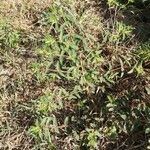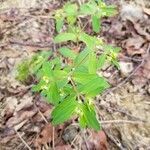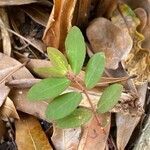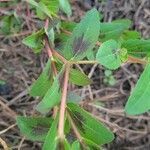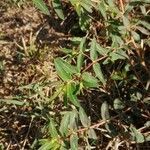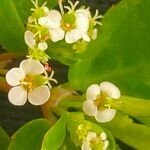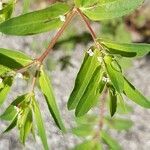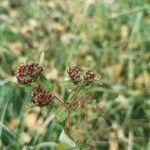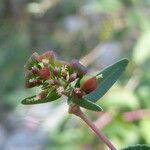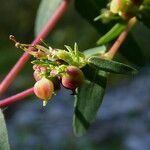Herbs, annual, with taproot. Stems usually ascending, occasionally erect, often arched at tips, 20–80 cm, sparsely to moderately pilose to villous or with short, incurved hairs, hairs often concentrated at nodes and distally, occasionally in 2 bands along opposite sides of stem. Leaves opposite; stipules usually distinct, sometimes connate basally on one side of stem, small scales, irregularly toothed, fringed, or divided, 1–1.5 mm, sparsely to moderately villous distally; petiole 0.3–1.6 mm, moderately pilose to villous; blade oblong to oblong-lanceolate, 8–40 × 3–12 mm, base asymmetric, one side usually angled or rounded, other side ± truncate to cordate-auriculate, margins serrulate, apex angled with blunt tip, abaxial surface pale green or faintly to strongly reddish tinged, adaxial surface usually reddish-mottled or with conspicuous reddish spot, both surfaces usually sparsely to moderately pilose, especially toward base, sometimes glabrous; 3–5-veined from base, pinnate distally, veins faint. Cyathia solitary at distal nodes or in small, cymose clusters at branch tips; peduncle 0.5–2.5 mm. Involucre narrowly obconic, 0.5–1 × 0.3–0.7 mm, glabrous; glands 4, usually green, sometimes reddish purple, oblong to nearly circular, 0.2–0.4 × 0.3–0.5 mm; appendages white or pinkish, ovate to broadly elliptic, 0.2–1 × 0.2–1.5 mm, distal margin entire. Staminate flowers 5–28. Pistillate flowers: ovary glabrous; styles 0.6–2.5 mm, 2-fid 1/2 length. Capsules ovoid, 1.6–2.3 × 1.5–2.4 mm, glabrous; columella 1.4–1.6 mm. Seeds dark brown, sometimes with thin, white coating (often more persistent along angles than faces), elliptic-ovoid to ovoid, rounded-angular in cross section, 1–1.6 × 0.5–0.8 mm, surface finely and irregularly wrinkled, sometimes faintly so, or with indistinct, shallow, rounded cross ridges. 2n = 12, 14, 22.
More
Usually ascending annual. Stems with a stripe of hairs at young tips, ± glabrous or evenly moderately hairy below, branched or not from base, up to 40-(50) cm long. Lvs opposite, ± glabrous above and below, or sparsely hairy near base, shortly petiolate, serrate, elliptic-oblong, acute to obtuse, asymmetric at base, (8)-10-30 mm long, often with a reddish purple spot about midvein; stipules triangular, serrate, at least partly fused, 1-2 mm long. Cyathia solitary at nodes or in small axillary leafy clusters along branches; subtending lvs similar to stem lvs. Glands ovate, with large white or pink petaloid appendages. Capsules smooth, glabrous, grooved, with sharp keels. Seeds rugulose, 4-angled, dark brown to black, c. 1.2 mm long.
Annual; stems to 8 dm, obliquely ascending at least in the upper half, the lower half often erect, the younger parts puberulent, often in a single longitudinal strip, with usually incurved hairs to 0.3 mm, the older parts glabrous or nearly so; lvs opposite, oblong or oblong-ovate, 1–3.5 cm, about a third as wide, serrulate, usually conspicuously inequilateral; fr 2–2.5 mm, strongly 3-lobed, glabrous; seeds gray or pale brown, 1–1.5 mm; 2n=12. Dry or moist soil; N.H. to Mich. and N.D., s. to Fla. and Tex.; abundant as a weed in lawns and gardens and intr. elsewhere in the world. June–Oct. (E. maculata, misapplied; E. preslii; Chamaesyce rafinesquii)
